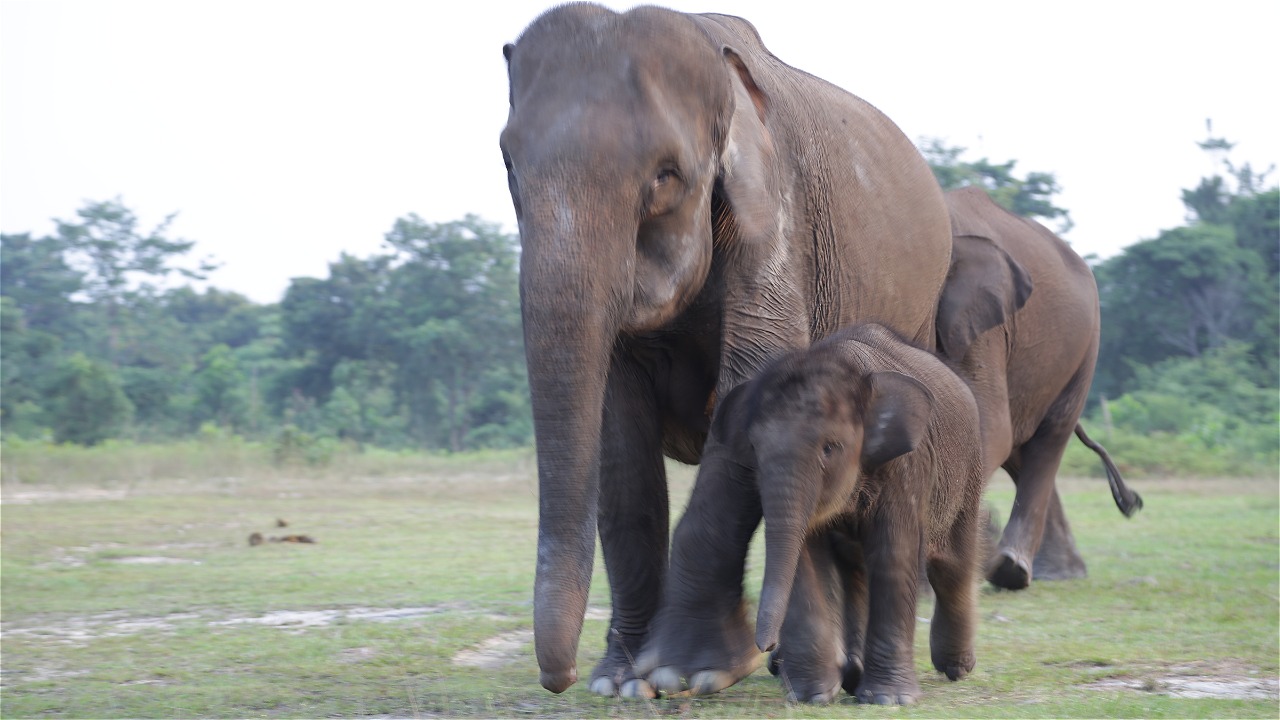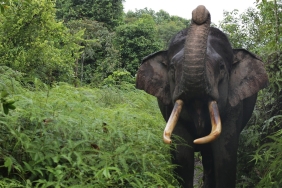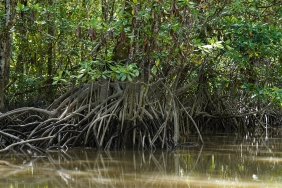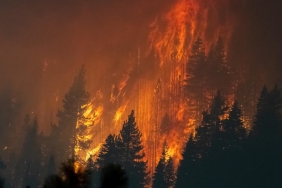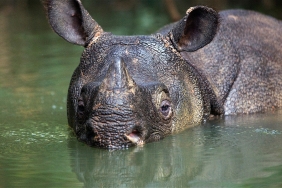ELEPHANT HERDING
By: Chik Rini
At dusk in early September, Muslim received a phone call from the Reje (Village Chief) of Karang Ampar. An elephant had entered the rice fields in Pantan Jerik hamlet, eating the yellowing rice. As the head of Karang Ampar-Bergang Flora and Fauna Safeguards (TPFF), Muslim immediately contacted some of his team to be ready to go, he also contacted some village elders who were experienced in herding elephants. They had to get the elephant out of the village immediately.
Tonight about 15 people moved to herd the elephant across the Bersah river near the forest. They carry mercon, spirtus cannon, flashlight. Shouting "Surut Abang Kol" to keep the elephants away from them. It took 6 hours of walking to lead the elephants out. They were very tired. Because the road was uneven, they went into the bushes and sometimes fell down.
The night's work was done. But two days later a larger group of elephants reportedly entered the village from a different direction. "For the time being we haven't herded the more crowded elephants out, because it's not easy," said Muslim.
TPFF then began conducting security patrols to control the elephants' movements. As long as the elephant group was still in the young forest area near the village, they did not herd them out.
At the end of the year when the rainy and windy seasons occur, it is the time when elephant herds spread into the villages around the Peusangan river valley. Karang Ampar in Central Aceh District is not the only village in conflict with elephants. The area, which straddles the border between the three districts of Aceh Tengah, Bener Meriah and Bireuen, is an area of severe human-elephant conflict, with five people killed by elephants and three elephants killed by poisoning, poaching for their tusks and falling into elephant-blocking trenches.
The area is a fertile region known for its cattle fields, sugarcane, durian and coffee plantations. Peusangan is one of Aceh's elephant enclaves. There are 50-60 elephants inhabiting the Peusangan valley, split into groups with females, juvenile males and their calves. Some adult males live separately from the group.
This is the worst area of elephant-human conflict in Aceh, straddling the border between the districts of Central Aceh, Bener Meriah and Bireuen. In an area of about 30,000 hectares elephants move along their traditional paths through places that have been turned into gardens and houses.
The main elephant movement path is below the Peusangan river valley. Residential areas and community gardens are on the hills. August to December is when elephants often enter villages to eat bananas, sugar cane, pineapples, areca nuts, damage cacao stalks, and eat palm leaves.
Since 2015, WWF Indonesia has been providing assistance to villages experiencing conflict with wild elephants in Aceh. Initially, this was one of the responses made by WWF after the death of a farmer named Hasan Basri who was attacked by an elephant when he and Team Eight were herding elephants out of the residents' plantation area in Pintu Rime Gayo, Bener Meriah Regency in October 2014.
Team Eight is an elephant-human conflict mitigation team formed at the initiative of the community led by Suherry, an animal activist in Bener Meriah. They had never received any training or knowledge about elephant herding techniques. Everything is learned through trial and error in the field.
Team Eight was the first team trained by WWF's Flying Squad who came from Riau. Today this group often helps the government to herd elephants out of villages back to their main path in the Peusangan river valley.
Team of Eight inspired WWF to strengthen villages in the Peusangan watershed that are in conflict with elephants. One of them is the Karang Ampar Bergang TPFF. There is also an elephant team in Pante Peusangan Village, Bireuen. These three community groups received training and mentoring for 4 years from WWF. The training is not only done once, but many times, because they will be evaluated on the extent to which they apply the techniques taught.< br />
Actually, almost all people in the village have done elephant driving, either using mercon, bamboo cannon, even more extreme is throwing fire to the elephant's body. When WWF came to the village with the Flying Squad Team from Riau, we needed to convince the villagers how they should abandon the violent ways of dealing with elephants. Because no wonder elephants become aggressive and attack humans because of their trauma.
WWF disseminates conflict mitigation practices that have been tested for 20 years by the Flying Squad team on how to lead techniques, safe distances, reading elephant behavior and avoiding unsafe ways of conducting conflict mitigation so that casualties on both sides (humans and elephants) can be avoided.
WWF trains to make and use low-cost conflict mitigation tools: carbide cannons and smoke boli. These low-cost tools can be one of the solutions to replace the use of expensive firecrackers every time an elephant is driven. In each training, WWF assists with carbide cannon equipment such as tubes and pipes which are then assembled by the participants.
WWF always reminds the principles of elephant herding. "What we do is to build communication with elephants. The cannon is not a tool to scare the elephants. But it is our communication tool with elephants. With the hope that every elephant hears the sound of the cannon, it is a message to the elephant: Hey elephant, you have to go away from the sound of the cannon," said Syamsuardi, a trainer from Flying Squad when he started training Acehnese at that time.
The head of TPFF Karang Ampar Bergang Muslim said that there were many changes after the community received training from WWF. "We are now more united in the community. We don't have to wait for help from the government, if we can still handle it, we can herd the elephants out of the village," he said. "We are more tactical in herding elephants because we direct the elephants where to go. In the past, we just followed the elephant where it wanted to go, which made the elephant go around in circles and took longer. With this team in our village, it is easier to control the safety of the elephant herders."
"In the past, we did not consider the safety of our lives, we were too brave to get close to the elephants, so some of our members became victims. Now we know the safe distance that must be at least 50 meters," said Suherry.
WWF assistance is also carried out in other places. In Krueng Sabee, Aceh Jaya Regency, the community of 7 villages there also formed the Krueng Sabee Elephant Care Community Forum. Uniquely, one member of this Forum is a woman because she lives in her garden where the elephants come and go. In addition, in Cot Girek and Langkahan sub-districts in North Aceh, WWF also began to form community teams after they received training.
They are volunteers who move to herd the garah every time it enters the community garden area. "We are not paid. This is voluntary work because of the common interest to secure our source of livelihood," said Junaidi, head of the Cot Girek Elephant Team.
WWF not only provides assistance to strengthen the ability of the team that has been trained. They received further training on techniques to identify elephants through dung and tracks, as well as designing early detection devices and monitoring towers at elephant entrances. It is hoped that these teams at the village level can play a big role as part of the effort to save humans and elephants from the impact of conflicts that are often not handled properly.

